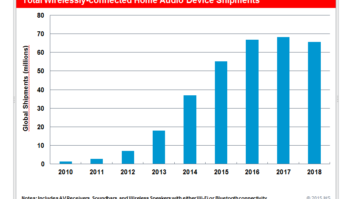The wireless multiroom-audio market is still relatively untapped despite years of growth, prompting more suppliers here to enter the market and others to expand their selections despite a sales-growth slowdown.
Newcomers to the business include Jam, iLuv, Klipsch and Riva, and companies that recently entered the market — Raumfeld and Naim — are expanding their selections, as are Paradigm and Wren.
Also at the show, dealers will find more model supporting high-res audio payback, with Harman Kardon adding its first and Raumfeld expanding its line of high-res models.
“The multi-room audio market has experienced significant growth year over year,” said Kevin Zarow, D+M Group VP/GM for the Americas. “Since everyone wants a piece of it, more offerings will become available as we move in fiscal year 2016. Sound quality and high-resolution audio will be key differentiators going forward.”
Demand is there, Futuresource Consulting said. “Consumer research among intending wirelessspeaker purchasers [including Bluetooth speakers] indicates a great opportunity here. Thirty-three percent want to be able to play the same music simultaneously throughout their home, yet only 8 percent of the wireless speaker market [including Bluetooth and Wi-Fi speakers] is currently multiroom.”
Multiroom faces a challenge, however. The “sheer range of products and – in some cases — complex technology has caused confusion at retail,” Futuresource said. “This needs to be resolved in order to capitalize upon latent demand.”
NPD Group analyst Ben Arnold agreed. Multiroom audio “outside Sonos has not grown as fast as I expected,” He said. A key reason is customer confusion over the advantages of Wi-Fi versus Bluetooth. “There has not been as much consumer education as there needs to be,” he said. “The momentum is behind lower cost Bluetooth speakers.”
Suppliers also face another challenge: Sonos, which dominates the market with an 89 percent share of retail-level dollars in the 12 months ending July 2015, NPD statistics show.
Differentiation: For that reason, many suppliers are trying to differentiate themselves on sound quality or by incorporating the technology in component-audio products. Yamaha, for example, offers its MusicCast technology in AVRs, a two-channel stereo receiver, a pair of powered left-right monitor speakers, two soundbars, an under-TV speaker base, an A/V preamp processor, and a single-chassis tabletop speaker.
Said Bob Goedken, GM of Yamaha’s AV division, “Customers will be demanding more access to their content — external, high-resolution, streaming music services, Bluetooth, etc. — in more areas of their homes and want an ecosystem that seamlessly integrates this with a simple app that controls any type of audio gear …” Too many other suppliers “have just tried to copy the current industry market-share leader, but we’re offering different solutions to a different customer.”
Another way to differentiate is to let anyone with a Bluetooth device stream music to a multiroom-audio speaker that in turn rebroadcasts the stream over Wi-Fi to other speakers. Naim offers that feature, among others.
“The outlook for wireless multiroom audio “continues to look positive,” Said Harman SVP/GM Dave Rogers.
Growth potential is due in part to the market’s low penetration numbers. Yamaha pointed out that of 116 million U.S. households, only 3 million use a wireless multiroom system.
For its part, Denon expects 2015 retail-level dollar growth of 10 to 15 percent to around $400 million to $500 million (excluding multiroom-equipped soundbars), down from 2014’s approximate 20 percent gain. Retail-level unit sales were expected in the range of 1.1 to 1.3 million in 2015, Denon said.
Yamaha takes a more expansive view, estimating 2015 consumer-level sales of $1 billion when factoring in multiroom-equipped soundbars and custom-install-dedicated products, excluding wireless-multiroom-equipped audio/video receivers.
Though sales potential remains high, growth nonetheless slowed in 2015, The NPD Group found. Sales of all networked speakers, including AirPlay and Sonos-like wireless-multiroom speakers, grew 11 percent in dollars to $275.4 million for the 12 months ending October 2015, down from the year-ago 70 percent dollar gain. Unit sales fell during that time by 9 percent to 1 million units compared to year-ago growth of 84 percent.







